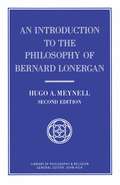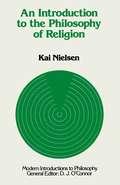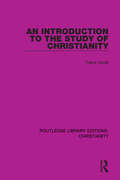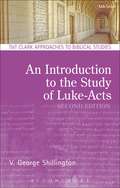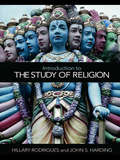- Table View
- List View
An Introduction to the Philosophy of Bernard Lonergan (Library Of Philosophy And Religion Ser.)
by Hugo A. MeynellThis is an introduction to the philosophy of a Christian thinker of the 20th century. The author pursues his thesis through mathematics, empirical science, common sense, depth psychology and social theory, into metaphysics, ethics and natural theology.
An Introduction To The Philosophy Of Religion: (PDF)
by Brian Davies"A deep and precise introduction to the philosophy of religion that is also remarkably clear and insightful. The author has a conversation with the student and uses concrete examples to explain often abstract concepts and issues".
An Introduction to the Philosophy of Religion (Modern Introductions To Philosophy Ser.)
by K. NeilsonIntroduction to the Qur'an (London Qur'an Studies)
by M.A. DrazA BRILLIANT SURVEY OF THE QUR'AN BY A TOWERING MUSLIM AUTHORITY, AVAILABLE FOR THE FIRST TIME IN PAPERBACK.What is new in the Qur'an? What was the nature of the Qur'anic revelation? Was the Qur'an the product of the mind of Muhammad or the influence of Jewish or Christian teachings? Was it the creation of Arabia or of other religious traditions from the Near and Middle East? And how was the Qur'anic message transmitted: by the sword or by persuasion?The Qur'an is understood by Muslims and non-Muslims alike as the source and fountainhead of Islam. But very few non-Muslims (and surprisingly few Muslims) have a real understanding of the nature and historical background of the revelations which came to the Prophet Muhammad.Introduction to the Qur'an sets out the fundamental principles of the Qur'an and its much misunderstood and misquoted teachings. The distinguished Islamic scholar M. A. Draz, one of the Muslim world's most erudite authorities of the twentieth century, examines Qur'anic instruction on women, polygamy, war, faith, Judaism,Christianity and the many other issues on which the Qur'an pronounces. The author emphasizes the continuity of monotheistic doctrine and ethics through Judaism, Christianity and Islam in this ideal starting point to an appreciation ofwhat lies at the core of Muslim life and belief.
Introduction to the Qur'an (The New Edinburgh Islamic Surveys)
by William Montgomery Watt Richard BellSurveying the life, aims, character and inspiration of Muhammad, this classic introduction explains the history, form and chronology of the Qur'an, and gives the views of Muslim and Occidental scholars.
Introduction to the Sociology of Missions (Non-ser.)
by Robert L. MontgomeryWhile much work has been done to apply anthropological insights to the study of missions, the sociological perspective has been generally neglected by missiologists. This volume defines the sociology of missions as a discrete subdiscipline within the sociology of religion and provides a working set of conceptual resources for those involved in mission work to use in furthering their understanding of their task. The author reviews the major areas of sociology that are most relevant to missions and presents his findings as a basis for discussion and a stimulus to further exploration of relevant sociological concepts and theories. One of his main goals is to increase dialogue between missiologists and sociologists of religion, by providing the former with a sociological perspective and the latter with a deeper understanding of the missionary enterprise.
An Introduction to the Sociology of Religion: Classical and Contemporary Perspectives
by Inger Furseth Pål RepstadIs it true that religion is weakening in modern times, or are we facing religious resurgence? What is fundamentalism? How does it emerge and grow? What role does religion play in ethnic and national conflicts? Is religion a fundamental driving force or do political leaders use religion for their own purposes? Do all religions oppress women? These are some of the questions addressed in this book. An Introduction to the Sociology of Religion provides an overview of sociological theories of contemporary religious life. Some chapters are organized according to topic. Others offer brief presentations of classical and contemporary sociologists from Karl Marx to Zygmunt Bauman and their perspectives on social life, including religion. Throughout the book, illustrations and examples are taken from several religious traditions.
An Introduction to the Sociology of Religion: Classical and Contemporary Perspectives
by Inger Furseth Pål RepstadIs it true that religion is weakening in modern times, or are we facing religious resurgence? What is fundamentalism? How does it emerge and grow? What role does religion play in ethnic and national conflicts? Is religion a fundamental driving force or do political leaders use religion for their own purposes? Do all religions oppress women? These are some of the questions addressed in this book. An Introduction to the Sociology of Religion provides an overview of sociological theories of contemporary religious life. Some chapters are organized according to topic. Others offer brief presentations of classical and contemporary sociologists from Karl Marx to Zygmunt Bauman and their perspectives on social life, including religion. Throughout the book, illustrations and examples are taken from several religious traditions.
An Introduction to the Sociology of Religion: Classical and Contemporary Perspectives
by Inger Furseth Pål RepstadWhat are religion and nonreligion? How do fundamentalism and religious radicalization emerge and grow? How do social class, gender, sexuality, race, ethnicity, and other factors affect religious beliefs, practices, and organizations? Is religion a fundamental driving force or do political leaders use religion for their own purposes? In exploring these pertinent questions, An Introduction to the Sociology of Religion provides an overview of sociological theories of contemporary religious life. Theoretical discussion is accompanied by presentations of empirical research from several religious traditions in many parts of the world. The sociology of religion is linked closely to developments in general sociology. Some chapters are organized according to topic, while others offer brief presentations of classical and contemporary sociologists from Karl Marx to Patricia Hill Collins and their perspectives on social life, including on religion. This second edition has been thoroughly updated throughout with new chapters on religion and social inequalities, social and religious movements, and extremism. Covering classical sociology of religion as well as contemporary debates and topics, this book is ideal reading for students approaching the sociology of religion for the first time.
An Introduction to the Sociology of Religion: Classical and Contemporary Perspectives
by Inger Furseth Pål RepstadWhat are religion and nonreligion? How do fundamentalism and religious radicalization emerge and grow? How do social class, gender, sexuality, race, ethnicity, and other factors affect religious beliefs, practices, and organizations? Is religion a fundamental driving force or do political leaders use religion for their own purposes? In exploring these pertinent questions, An Introduction to the Sociology of Religion provides an overview of sociological theories of contemporary religious life. Theoretical discussion is accompanied by presentations of empirical research from several religious traditions in many parts of the world. The sociology of religion is linked closely to developments in general sociology. Some chapters are organized according to topic, while others offer brief presentations of classical and contemporary sociologists from Karl Marx to Patricia Hill Collins and their perspectives on social life, including on religion. This second edition has been thoroughly updated throughout with new chapters on religion and social inequalities, social and religious movements, and extremism. Covering classical sociology of religion as well as contemporary debates and topics, this book is ideal reading for students approaching the sociology of religion for the first time.
An Introduction to the Study of Christianity
by Frank DoddOriginally published in 1938, An Introduction to the Study of Christianity is a consideration of what is truly essential in the Christian faith. The book provides a detailed survey of key elements relating to the origin and growth of Christianity, and puts forward the argument that any apparent blemishes or mistakes are the result of human imperfection and misunderstanding of the real teaching of Jesus and his immediate followers, rather than of any shortcomings in the teaching itself. It first sets out the foundations of Christianity and then calls attention to the different interpretations that successive generations of Christians have placed on them. Exploring the history of the Christian faith up to the 1930s, An Introduction to the Study of Christianity will appeal to those with an interest in the history of religion, Christianity, theology, and religious studies.
An Introduction to the Study of Christianity
by Frank DoddOriginally published in 1938, An Introduction to the Study of Christianity is a consideration of what is truly essential in the Christian faith. The book provides a detailed survey of key elements relating to the origin and growth of Christianity, and puts forward the argument that any apparent blemishes or mistakes are the result of human imperfection and misunderstanding of the real teaching of Jesus and his immediate followers, rather than of any shortcomings in the teaching itself. It first sets out the foundations of Christianity and then calls attention to the different interpretations that successive generations of Christians have placed on them. Exploring the history of the Christian faith up to the 1930s, An Introduction to the Study of Christianity will appeal to those with an interest in the history of religion, Christianity, theology, and religious studies.
An Introduction to the Study of Ezekiel
by Michael A. LyonsAn introduction to the study of Ezekiel that lays out for the reader the central issues for the interpretation of the book of Ezekiel. After explaining how the message of the prophet was relevant to the exilic situation in which he lived, this thorough guide shows how later generations shaped, transmitted, and used Ezekiel in their own communities.The book summarizes the literary shape and contents of Ezekiel, then examines the theories and methodologies used in current scholarship that explain the formation of Ezekiel. Lyons next explains for the reader the theology and major themes of Ezekiel, and closes by evaluating how the arguments of Ezekiel relate to each other as a coherent rhetorical strategy.
An Introduction to the Study of Ezekiel (T&t Clark Approaches To Biblical Studies)
by Michael A. LyonsAn introduction to the study of Ezekiel that lays out for the reader the central issues for the interpretation of the book of Ezekiel. After explaining how the message of the prophet was relevant to the exilic situation in which he lived, this thorough guide shows how later generations shaped, transmitted, and used Ezekiel in their own communities.The book summarizes the literary shape and contents of Ezekiel, then examines the theories and methodologies used in current scholarship that explain the formation of Ezekiel. Lyons next explains for the reader the theology and major themes of Ezekiel, and closes by evaluating how the arguments of Ezekiel relate to each other as a coherent rhetorical strategy.
An Introduction to the Study of Isaiah (T&T Clark Approaches to Biblical Studies)
by Jacob StrombergAn Introduction to the Study of Isaiah guides readers through the central issues in scholarship on this influential prophetic text. Readers will be introduced to the diverse methods and results of modern Isaianic study. They will see how these approaches differ from, and relate to one another. After a brief introduction, this book analyzes various proposals for the Isaiah's formation, the contributions of literary theory to understanding it, and finally theological approaches to the book. Because of its emphasis on method, this introduction will be important for students concerned with negotiating the vast and diverse body of scholarly literature that now surrounds this central biblical book.
An Introduction to the Study of Jeremiah (T&T Clark Approaches to Biblical Studies)
by C. L. CrouchC. L. Crouch provides a clear and concise introduction to the complex text of Jeremiah. Readers are introduced to the diverse approaches to the book, with attention paid to the way that these approaches differ from but also relate to one another. After a brief introduction, Crouch addresses the formation of the book, especially in relation to its Hebrew and Greek versions; the theological interests of the book and the challenges posed by attempts to link these to an actual man 'Jeremiah'; and the relationship of Jeremiah to other biblical prophets. Crouch focuses clearly on method and on approaches to the text, as is the mark of this series. This makes the book especially useful for students in the quest to navigate the diverse body of scholarly literature that surrounds this troublesome biblical book.
An Introduction to the Study of Jeremiah (T&T Clark Approaches to Biblical Studies)
by C. L. CrouchC. L. Crouch provides a clear and concise introduction to the complex text of Jeremiah. Readers are introduced to the diverse approaches to the book, with attention paid to the way that these approaches differ from but also relate to one another. After a brief introduction, Crouch addresses the formation of the book, especially in relation to its Hebrew and Greek versions; the theological interests of the book and the challenges posed by attempts to link these to an actual man 'Jeremiah'; and the relationship of Jeremiah to other biblical prophets. Crouch focuses clearly on method and on approaches to the text, as is the mark of this series. This makes the book especially useful for students in the quest to navigate the diverse body of scholarly literature that surrounds this troublesome biblical book.
An Introduction to the Study of Luke-Acts (T&T Clark Approaches to Biblical Studies)
by V. George ShillingtonV. George Shillington introduces readers to the text, texture and context of Luke-Acts in this tried and tested introduction, now in its second edition. Using various approaches currently practiced by biblical scholars Shillington outlines the methods of biblical interpretation and then shows how they might be applied to the texts in question.Through historical criticism Shillington looks at and explains questions of authorship, the time and setting of the composition, sources and historical background. Taking a social-science approach he examines the society and culture of the time. Literary readings include narrative, socio-rhetorical, and audience-response approaches, while a theological reading asks how the literary texture and themes of Luke-Acts shape the convictions of Christian communities, past and present. Incorporating modern approaches in the field, Shillington looks at postcolonial and feminist criticism and how they have changed our understanding of these books. Each chapter concludes with a list of further relevant resources, and pertinent review questions. The text is accompanied by charts and diagrams to illustrate key points of language and structure.
An Introduction to the Study of Luke-Acts (T&T Clark Approaches to Biblical Studies)
by V. George ShillingtonV. George Shillington introduces readers to the text, texture and context of Luke-Acts in this tried and tested introduction, now in its second edition. Using various approaches currently practiced by biblical scholars Shillington outlines the methods of biblical interpretation and then shows how they might be applied to the texts in question.Through historical criticism Shillington looks at and explains questions of authorship, the time and setting of the composition, sources and historical background. Taking a social-science approach he examines the society and culture of the time. Literary readings include narrative, socio-rhetorical, and audience-response approaches, while a theological reading asks how the literary texture and themes of Luke-Acts shape the convictions of Christian communities, past and present. Incorporating modern approaches in the field, Shillington looks at postcolonial and feminist criticism and how they have changed our understanding of these books. Each chapter concludes with a list of further relevant resources, and pertinent review questions. The text is accompanied by charts and diagrams to illustrate key points of language and structure.
An Introduction to the Study of Paul (T&T Clark Approaches to Biblical Studies)
by David G. HorrellThis tried and tested introduction to Paul needs little introduction of its own. After considering Paul's importance and influence, and the important sources for the study of Paul, the volume covers the following key topics: the earliest period of Christianity - from Jesus to Paul; Paul's life before and after his 'conversion'; his individual letters; the major elements of his theology; his attitude to Israel and the Jewish law; perspectives on the Pauline assemblies, including their socio-economic location, meeting places, and attitudes towards women; and Paul's legacy in the New Testament and beyond. The volume has been revised throughout and fully updated with respect to bibliography, and to presenting the latest debates surrounding Paul's thought in a manageable format - including those around 'old' and 'new' perspectives, with a new section on the 'radical' new Jewish perspective, and those related to the socio-economic status and character of the Pauline assemblies. The helpful study questions and reading lists have also been revised.
An Introduction to the Study of Paul (T&T Clark Approaches to Biblical Studies)
by David G. HorrellThis tried and tested introduction to Paul needs little introduction of its own. After considering Paul's importance and influence, and the important sources for the study of Paul, the volume covers the following key topics: the earliest period of Christianity - from Jesus to Paul; Paul's life before and after his 'conversion'; his individual letters; the major elements of his theology; his attitude to Israel and the Jewish law; perspectives on the Pauline assemblies, including their socio-economic location, meeting places, and attitudes towards women; and Paul's legacy in the New Testament and beyond. The volume has been revised throughout and fully updated with respect to bibliography, and to presenting the latest debates surrounding Paul's thought in a manageable format - including those around 'old' and 'new' perspectives, with a new section on the 'radical' new Jewish perspective, and those related to the socio-economic status and character of the Pauline assemblies. The helpful study questions and reading lists have also been revised.
Introduction to the Study of Religion
by John S. Harding Hillary P. RodriguesWhy do people study religion? How have they studied it in the past? How do we study religion today? Is the academic study of religion the same as religious education? These and many other questions are addressed in this engaging introduction to the discipline of religious studies, written by two experienced university teachers. The authors have crafted this book to familiarize novice students with key concepts and terminology in the study of religion. More advanced students will find a varied array of theoretical perspectives and methodological approaches to the field. Topics include: definitions of religion perspectives in the study and teaching of religion how religion began to be studied: traditional perspectives – philosophical and theological how people experience religion: perspectives in the study of religious consciousness and perception – phenomenological and psychological studying religion within communities: Social and cultural perspectives – anthropological, sociological, political and economic judging religion: critical perspectives –feminist approaches, the interaction of popular literature and religion contextual perspectives – historical and comparative. The book encourages students to think critically about the theories and methods presented. Students will find arguments for the strengths and limitations of these approaches, understand connections among religious studies and other intellectual movements, and develop their own ideas of how they might want to go about the study of religion. Summary boxes, a timeline, a glossary and other pedagogic aids help students grasp key concepts, along with a companion website at www.sastor.com.
Introduction to the Study of Religion
by Hillary P. Rodrigues John S. HardingWhy do people study religion? How have they studied it in the past? How do we study religion today? Is the academic study of religion the same as religious education? These and many other questions are addressed in this engaging introduction to the discipline of religious studies, written by two experienced university teachers. The authors have crafted this book to familiarize novice students with key concepts and terminology in the study of religion. More advanced students will find a varied array of theoretical perspectives and methodological approaches to the field. Topics include: definitions of religion perspectives in the study and teaching of religion how religion began to be studied: traditional perspectives – philosophical and theological how people experience religion: perspectives in the study of religious consciousness and perception – phenomenological and psychological studying religion within communities: Social and cultural perspectives – anthropological, sociological, political and economic judging religion: critical perspectives –feminist approaches, the interaction of popular literature and religion contextual perspectives – historical and comparative. The book encourages students to think critically about the theories and methods presented. Students will find arguments for the strengths and limitations of these approaches, understand connections among religious studies and other intellectual movements, and develop their own ideas of how they might want to go about the study of religion. Summary boxes, a timeline, a glossary and other pedagogic aids help students grasp key concepts, along with a companion website at www.sastor.com.
Introduction to the Study of Religion
by Hillary P. Rodrigues John S. HardingWhy do people study religion? How have they studied it in the past? How do we study religion today? Is the academic study of religion the same as religious education? These and many other questions are addressed in this engaging introduction to the discipline of religious studies. Topics include Definitions of religion Perspectives in the study and teaching of religion How religion began to be studied: Traditional perspectives—philosophical and theological How people experience religion: Perspectives in the study of religious consciousness and perception—phenomenological and psychological Studying religion within communities: Social and cultural perspectives—anthropological, sociological, political, and economic Judging religion: Critical perspectives—feminist approaches, the interaction of popular literature and religion Contextual perspectives—historical and comparative Themes, theories, and current directions The thoroughly updated second edition encourages students to think critically about the theories and methods presented. Students will find arguments for the strengths and limitations of these approaches, understand connections among religious studies and other intellectual movements, and develop their own ideas of how they might want to go about the study of religion. Summary boxes, discussion questions, a glossary, a chronology of key figures and texts, and other pedagogic aids help students grasp key concepts.
Introduction to the Study of Religion
by Hillary P. Rodrigues John S. HardingWhy do people study religion? How have they studied it in the past? How do we study religion today? Is the academic study of religion the same as religious education? These and many other questions are addressed in this engaging introduction to the discipline of religious studies. Topics include Definitions of religion Perspectives in the study and teaching of religion How religion began to be studied: Traditional perspectives—philosophical and theological How people experience religion: Perspectives in the study of religious consciousness and perception—phenomenological and psychological Studying religion within communities: Social and cultural perspectives—anthropological, sociological, political, and economic Judging religion: Critical perspectives—feminist approaches, the interaction of popular literature and religion Contextual perspectives—historical and comparative Themes, theories, and current directions The thoroughly updated second edition encourages students to think critically about the theories and methods presented. Students will find arguments for the strengths and limitations of these approaches, understand connections among religious studies and other intellectual movements, and develop their own ideas of how they might want to go about the study of religion. Summary boxes, discussion questions, a glossary, a chronology of key figures and texts, and other pedagogic aids help students grasp key concepts.
